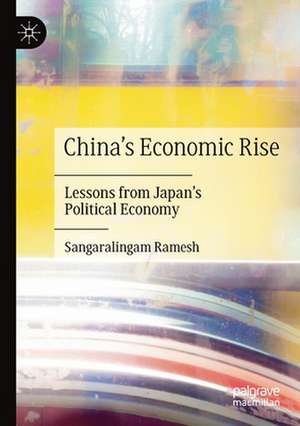China's Economic Rise: Lessons from Japan’s Political Economy
Autor Sangaralingam Rameshen Limba Engleză Paperback – 30 aug 2021
This book examines the economic and political rise of China from the perspective of Japan’s economic development. Beginning with Japan’s rise to statehood in the Kamakura Period (1185 to 1333) and detailing the evolution of its economy through to 2018, parallels are drawn with the economic development of China. Many of the challenges Japan faced in the first decades of the 20th century, including nationalism, militarism, income disparities, social deprivation, and economic crisis are applicable to modern day China.
China’s Economic Rise: Lessons from Japan’s Political Economy aims to detail the possible economic and political upheavals that could accompany the slowing of the Chinese economy from the experience of Japan. The book will be of interest to researchers and students in Political Economy, Economic History, Economic Transition, and Development Economics. The book supplements the other publications of the author: China’s Lessons for India:Volume 1 – The Political Economy of Development, China’s Lessons for India: Volume 2 – The Political Economy of Change and The Rise of Empires: The Political Economy of Innovation.
| Toate formatele și edițiile | Preț | Express |
|---|---|---|
| Paperback (1) | 697.65 lei 43-57 zile | |
| Springer International Publishing – 30 aug 2021 | 697.65 lei 43-57 zile | |
| Hardback (1) | 703.06 lei 43-57 zile | |
| Springer International Publishing – 30 aug 2020 | 703.06 lei 43-57 zile |
Preț: 697.65 lei
Preț vechi: 820.76 lei
-15% Nou
Puncte Express: 1046
Preț estimativ în valută:
133.50€ • 139.73$ • 111.11£
133.50€ • 139.73$ • 111.11£
Carte tipărită la comandă
Livrare economică 31 martie-14 aprilie
Preluare comenzi: 021 569.72.76
Specificații
ISBN-13: 9783030498139
ISBN-10: 3030498131
Pagini: 312
Ilustrații: XXII, 312 p. 1 illus.
Dimensiuni: 148 x 210 mm
Greutate: 0.44 kg
Ediția:1st ed. 2020
Editura: Springer International Publishing
Colecția Palgrave Macmillan
Locul publicării:Cham, Switzerland
ISBN-10: 3030498131
Pagini: 312
Ilustrații: XXII, 312 p. 1 illus.
Dimensiuni: 148 x 210 mm
Greutate: 0.44 kg
Ediția:1st ed. 2020
Editura: Springer International Publishing
Colecția Palgrave Macmillan
Locul publicării:Cham, Switzerland
Cuprins
1. Introduction.- 2. The Kamakura Period (1185AD-1333AD).- 3. The Muromachi Period (1333AD-1568AD) & Azuchi-Momoyama Period (1568AD-1600AD).- 4. The Tokugawa Period (1600AD-1868AD).- 5. The Meiji Period (1868AD-1912AD).- 6. The Taisho Period (1912AD-1926AD).- 7. The Showa Period (1926AD-1989AD).- 8. The Heisei Period (1989AD – 2019AD).- 9. Conclusion.
Notă biografică
Sangaralingam Ramesh is an Economics Tutor in the Department of Continuing Education at the University of Oxford and a Senior Teaching Fellow in Economics at University College London, UK. He has been an Associate Professor in Economics at the Université Paris Dauphine GBD and Economics Module Leader at Kings College London.
Textul de pe ultima copertă
This book examines the economic and political rise of China from the perspective of Japan’s economic development. Beginning with Japan’s rise to statehood in the Kamakura Period (1185 to 1333) and detailing the evolution of its economy through to 2018, parallels are drawn with the economic development of China. Many of the challenges Japan faced in the first decades of the 20th century, including nationalism, militarism, income disparities, social deprivation, and economic crisis are applicable to modern day China.
China’s Economic Rise: Lessons from Japan’s Political Economy aims to detail the possible economic and political upheavals that could accompany the slowing of the Chinese economy from the experience of Japan. The book will be of interest to researchers and students in Political Economy, Economic History, Economic Transition, and Development Economics. The book supplements the other publications of the author: China’s Lessonsfor India: Volume 1 – The Political Economy of Development, China’s Lessons for India: Volume 2 – The Political Economy of Change and The Rise of Empires: The Political Economy of Innovation.
Caracteristici
Outlines the rise of China in economic and technological terms with comparison to Japan Provides clear lessons from the Japan experience for China and its broader global context Delivers a new comparative analysis of these two important global economies
